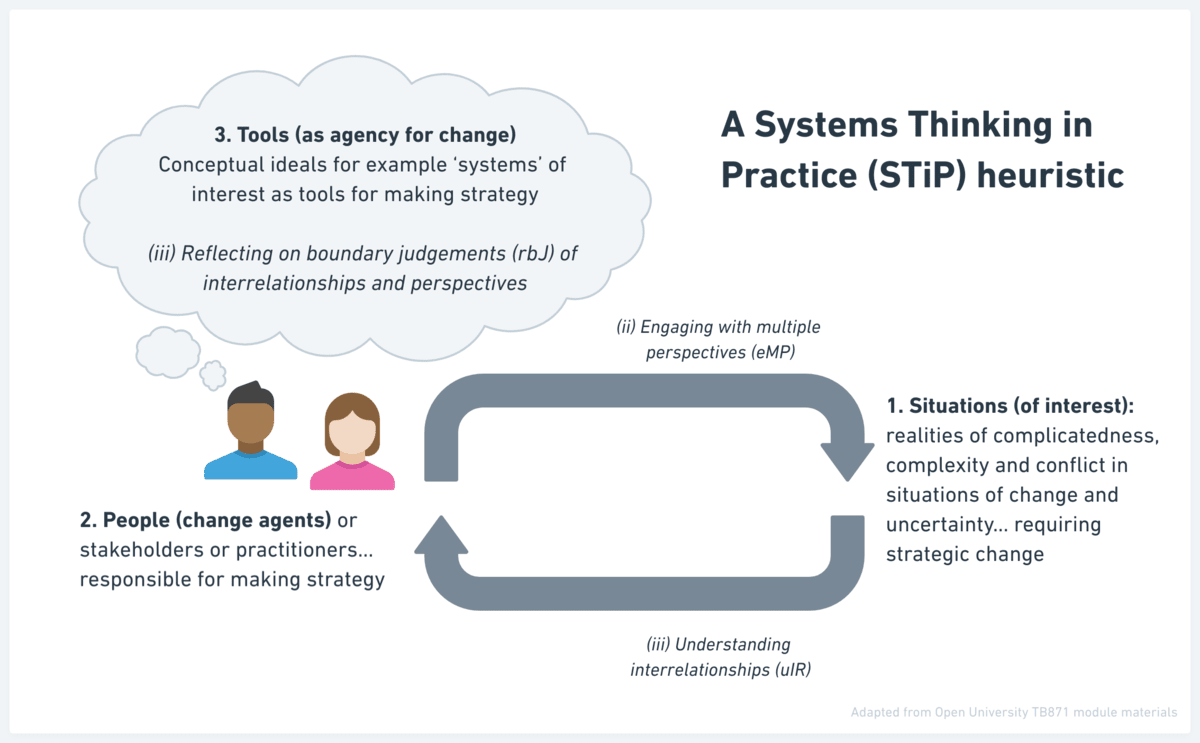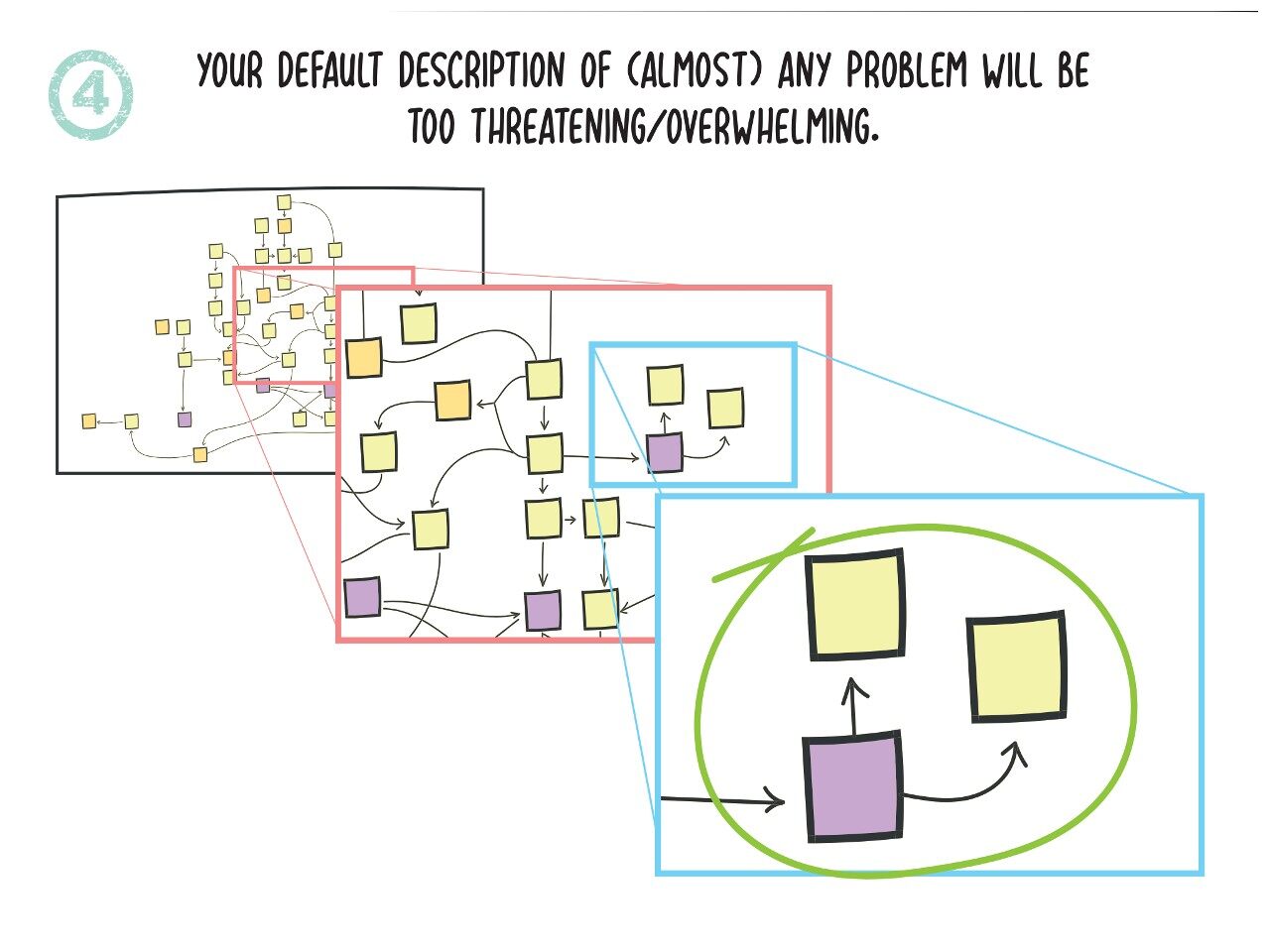TB871: Three activities associated with using a STiP heuristic for making strategy
Note: this is a post reflecting on one of the modules of my MSc in Systems Thinking in Practice. You can see all of the related posts in this category.
In a previous post, I recreated the STiP heuristic diagram that was introduced in the module materials:

This suggests three ‘conversations’ when using a bricolage approach: conversing with the situation (1), conversing with other practitioners about the situation (2), and conversing with yourself in reflecting on two prior conversations (3).
Activity 1.19 (Open University, 2020) asks what is specific in each conversation about STiP as praxis (i.e. the process by which a theory, lesson, or skill is enacted, practised, embodied, or realised)
Conversation 1: Situation
This conversation focuses on sense-making within complex, real-world situations, with the practitioner aiming to explore and examine these situations as an agent of change. As such, it emphasises the importance of developing an understanding of the interrelationships involved.
In addition, the practitioner is seeking through the ‘conversation’ to identify and connect relevant variables in order to form as holistic a picture as possible. It’s important to ensure that they are mindful that complexities do not always fit neatly into pre-defined views.
Third, this conversation centres on traditional Systems Thinking approaches which aim to see both the forest and threes. In other words, it involves understanding the larger system while recognising its individual components.
Conversation 2: Other Practitioners
This second conversation involves engaging with various practitioners to understand and strategise about the situation. This includes modelling different perspectives using systems tools to develop a shared model of action.
In this phase, the need to empathise with, and incorporate diverse, often contrasting, perspectives is foregrounded. The aim here is to develop effective strategies without dismissing views that could hinder their implementation.
The main focus here is on practical challenges, such as capturing perspectives and working with them to understand interrelationships more effectively and empathetically. This could be called collaborative modelling.
Conversation 3: Yourself
The third conversation is an internal, reflective process where the practitioner balances idealised systems models with the realities of the situation. This is a continuous process that involves reflecting on the boundaries and judgements made about the system designed to improve the situation.
Evaluating systemic desirability and cultural feasibilty of the strategies proposed is key to this phase. In other words, is this what people want, and is the change likely be able to happen given the culture surrounding it? Potential difficulties with implementation need to be addressed here, including extremes around holism (including everybody) and pluralism (including everybody’s views).
This conversation addresses the challenges of dealing with partiality and bias in making boundary judgements. Systems are human constructs, so they are inherently partial and biased, which means we must continually adapt to changing circumstances and stakeholder values.
I’ve come to enjoy figuring out boundary judgements over the last few months as I’ve been studying (Conversation 1) and I’m reasonably confident with Conversation 3 in terms of reflecting on my practice. I suppose it’s Conversation 2 in terms of dealing with other people’s differences in use of language and ways of understanding the world that I sometimes struggle with.
It’s also increasingly difficult to deal with people who neither have a background in STiP nor perhaps are ‘natural’ systems thinkers. With that, I found something recently by John Cutler on LinkedIn (thanks Amber and Abi!) which can help with that. I’ve included his full list below, and one of the illustrations by Viktor Cessan:

20 Things I’ve Learned as a Systems (Over) Thinker
- Take care of yourself. Your brain is working overtime—all the time. Practice “radical” recovery.
- You may spend a lot longer thinking about things than most people. Pace your delivery.
- If you go deep first, and then simplify…keep in mind that you don’t need to show all of your work.
- Your default description of (almost) any problem will be too threatening/overwhelming.
- Do your deepest thinking with co-conspirators (not the people you’re trying to influence).
- Informal influence is often not formally recognized. Prepare mentally for this.
- The people you’re trying to influence spend 98% of their day overwhelmed by business as usual.
- Remember to also do the job you were hired to do (if you don’t you’ll be easier to discount).
- Seek “quick wins”, but know that most meaningful things will take a while.
- Some things take ages to materialize. It is discontinuous, not continuous.
- Make sure to celebrate your wins. They will be few and far between, so savor the moment.
- The people who support you in private may not be able to support you in public. Accept that.
- Hack existing power structures—it’s much easier than trying to change them.
- Consider becoming a formal leader. It’s harder in many ways, but you’ll have more leverage. What’s stopping you?
- In lieu of being a formal leader, make sure to partner with people who actually “own” the area of change.
- Watch out for imposing your worldview on people. Have you asked about what people care about?.
- You’ll need a support network. And not just a venting network. Real support.
- “Know when to fold ‘em”. Listen to Kenny Rogers The Gambler. Leave on your own terms.
- Don’t confuse being able to sense/see system dynamics, with being about to “control” them. You can’t.
- Grapple with your demons, and make sure not to wrap up too much of your identity in change.
References
- The Open University (2020) ‘1.4.3 Bricolage and rigour’, TB872 Block 1 Systems and Strategy [Online]. Available at https://learn2.open.ac.uk/mod/oucontent/view.php?id=2261477§ion=5.3 (Accessed 18 May 2024).

